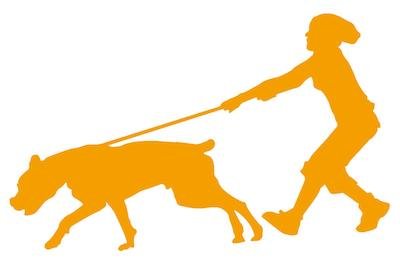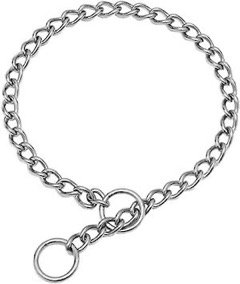What Is the Best Type of Dog Collar to Stop Pulling?
Average Reading Time: 5 minutes, 4 seconds
© Scott Sheaffer, CBCC-KA, CDBC, CPDT-KA, USA Dog Behavior, LLC
There is one thing to know about dog training; there are rarely any super-simple fixes for any dog behavior issue. I know, I know, you’ve read on the internet about all kinds of quick remedies to all kinds of dog behavior problems including leash pulling. Have you ever noticed that most of these solutions are “unknown until now” and, lucky for you, are now fully revealed to you for only $49.99? If only problematic dog behaviors, and life for that matter, were that simple.
Now on to the real world of dog training. I’m going to review and grade the eight most common dog collars and comment on how effective and humane they are for reducing pulling. I’m going to start with the least effective (#8) and work toward the most effective (#1). One of the key variables in my review is how humane these collars are. Punishing types of collars lose points fast with me.
Please remember there are 359,445 types of collars available - maybe more. I’m reviewing the most common types of collars. Furthermore, within the eight that I review below, there are hundreds of different styles and manufacturers for each of them.
#8 - Shock Collar
Shock Collar
Shock collars are also referred to as e-collars in order to hide the fact that they shock and hurt dogs. “E-collar” sounds less brutal, doesn’t it? This kind of collar has so many problems that I could quite literally write a book about them. Here are some of the big issues:
They frequently cause new, and more serious, behavior issues to emerge such as aggression.
They are dependent on the dog owner to have perfect timing when shocking the dog which is almost impossible for the average dog owner.
Dogs almost always desensitize to them so stronger and stronger levels of shock strength are required which only makes things worse.
They are inhumane.
Grade: F
#7 - Prong Collar
Prong Collar
These are collars that have prongs on the inside of the collar that essentially stab the dog’s neck when they pull. About the only thing prong collars have over shock collars is they don’t have any timing component in their use. The problems with this type of collar are almost exactly the same as with shock collars above:
They frequently cause new, and more serious, behavior issues to emerge such as aggression.
Dogs almost always acclimate to them so stronger and stronger levels of prong penetration are required which only makes things worse.
They are inhumane.
Grade: F+, I give it an F+ only because it is very slightly not as bad as shock collars.
#6 - Choke Collar
Choke Collar
These collars are normally made out of chain and constrict when the dog pulls. They essentially choke the dog when they pull. While not as bad as shock or prong collars, they are still painful and damaging to the dog. I use a rope type of choke collar sometimes in an emergency situation only because they immediately size to the dog’s neck. Once the dog is secured and safe, I will immediately remove it. The issues with this type of collar are:
They can cause new, and more serious, behavior issues to emerge such as aggression.
Dogs almost always desensitize to them so stronger and stronger levels of choking are required which only makes things worse.
They are inhumane, but not as much as shock and prong collars.
Grade: D
#5 (tie) - Top Attach Body Harness
#5 (tie) - Front Attach Body Harness
Body Harness
These are collars (actually harnesses) that wrap around the dog’s body. The leash is either attached to the front of the harness at the dog’s forechest (front attach) or on top of the dog (top attach). These are especially ineffective for large dogs. The front attach body harness always (and I mean always) ends up on the side of the dog which renders the advertised method of action ineffective. Head and neck control are essential concepts when controlling a dog and these types of harnesses don’t provide it. However, these types of collars (harnesses) aren’t all bad:
They do little to help control the dog.
Despite what you may hear, dogs can and do escape from these.
In many cases, they increase pulling for a number of reasons.
They are, at least, humane.
Grade: C
#3 - Head Halter
Head Halter
If you’ve never used one before, you’ve probably seen them in use. Many people think they are muzzles but they are not. They act very much like a horse’s halter (but not a bit and bridle) in that they control the front of a dog’s muzzle. In short, they pull the dog’s head sideways when they pull. This is a very effective tool to stop pulling. Here are some of the attributes of this kind of collar:
Dogs almost immediately stop pulling when using these.
There is an acclimation period for the dog and owner.
They can come off the dog.
They are humane.
Not all dogs will tolerate these.
Proper adjustment can be tricky.
While they stop pulling, when a standard collar is restarted, they almost always start pulling again.
Grade: B+, I recommend these to clients.
#2 - Martingale Collar
Martingale Collar
This is actually a combination or hybrid collar. It’s a standard flat collar (see below) with humane elements of a choke collar. They are standard collars (no chain or prongs) that have a limited amount of tightening when the dog pulls. This kind of collar features the following:
The limited and gentle tightening can act as a reminder to the dog not to pull.
They are humane.
Dogs that have small heads relative to their neck size can sometimes back out of collars; this helps prevent that from happening.
Proper adjustment can be tricky.
Grade: A-, I recommend these to clients.
#1 - Standard Flat Collar
Standard Flat Collar
My favorite type of collar. This is simply an old-school flat collar normally made out of nylon, cotton or leather. You may ask what makes this kind of collar so good. It’s not the collar; it’s the handler (i.e., the person managing the leash) that makes the difference. Proper technique and training are the key. The best parts about this type of collar are that they can provide permanent solutions to pulling and are humane. You may also ask why more people don’t recommend flat collars for pulling problems. Patience is the problem. Not patience from the dog, but from the handler. I recommend a flat collar with a belt buckle type of clasp because they are easily adjustable and don’t ever slip. Here’s why I prefer this kind of collar:
They are humane.
They provide good control.
Easy to put on and take off.
Can remain on the dog all of the time.
No acclimation period for dog or handler.
Can provide a permanent solution to pulling when proper and humane dog training methods are used.
They are easy to adjust.
Grade: A+, I recommend these to clients.
You may be disappointed if you were looking for an “unknown until now” dog collar to stop your dog from pulling. If only problematic dog behaviors, and life for that matter, were that simple.








